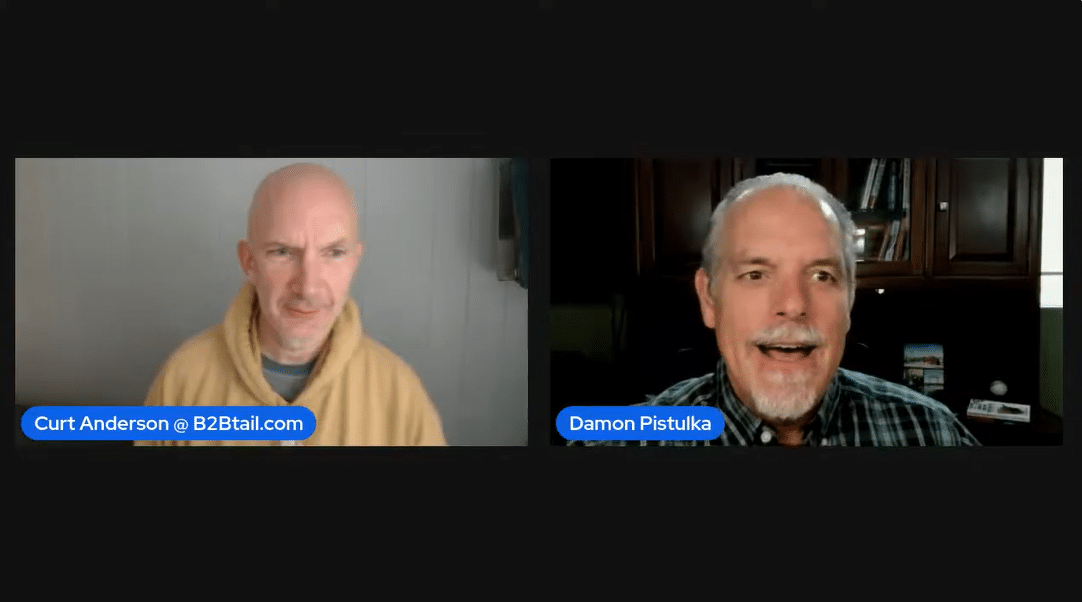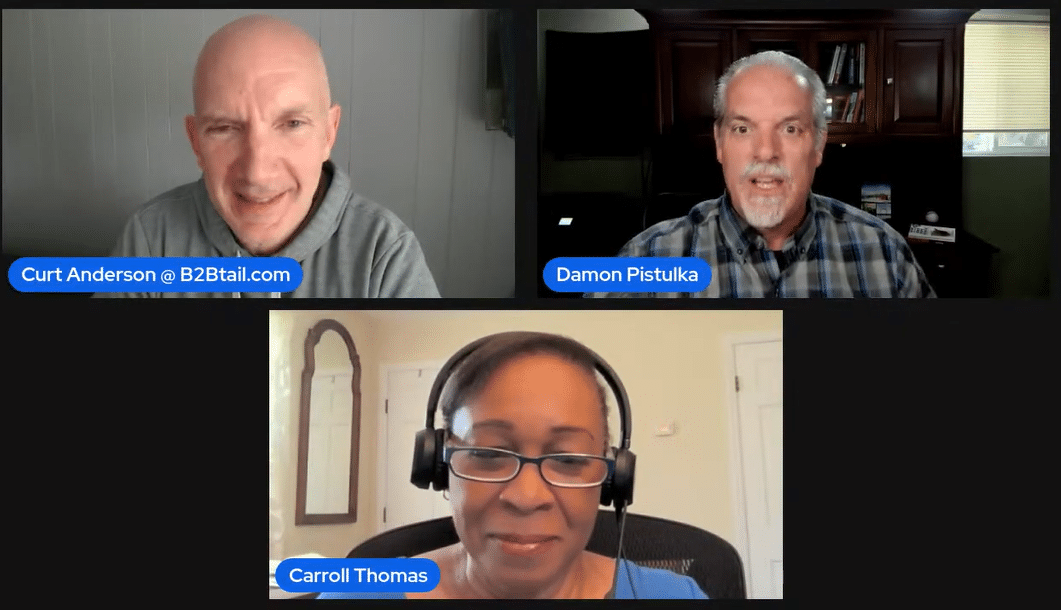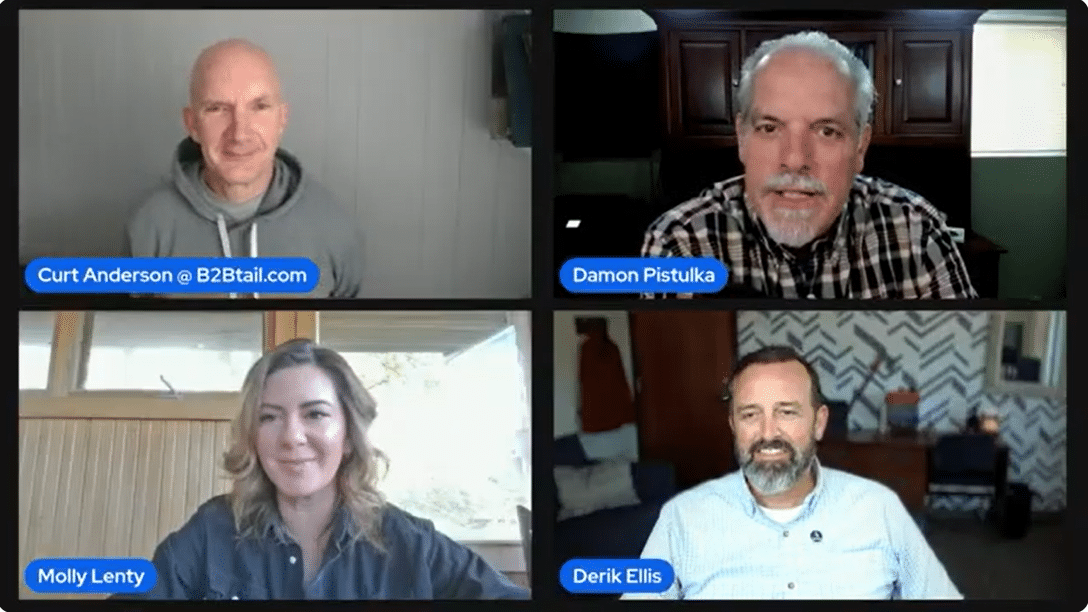• 27:58
SUMMARY KEYWORDS
ideal buyers, digital game plan, soulmate customers, customer challenges, niche down, buyer persona, customer’s customer, Amazon empty chair, remove friction, communication channels, target demographics, customer motivations, trusted guide, digital marketing, customer success
SPEAKERS
Curt Anderson, Damon Pistulka
Damon Pistulka 00:08
All right, everyone, it is Friday, and you know what that means? What’s it mean? Damon, it means it’s time for manufacturing, e commerce, success, and I am one of your co host, Damon Pistulka, that pretty gentleman right over there. Curt Anderson beside me, we’re going to be talking about understanding your soul mate, understanding your ideal buyers today, and talking about specifically how we do that in the digital game plan. Curt, awesome having you today. Hey, thanks,
Curt Anderson 00:43
dude, great to be here. Happy Friday. Do you feel lucky? Happy Friday 13th, man, yes, I do. I’ve been very lucky today. What do you feel lucky about? You know what? I feel lucky that
Damon Pistulka 00:55
I got up good day. Happening so far. Lots of fun. Lots of fun. And I do fun.
Curt Anderson 01:02
I couldn’t agree more. So what you know, just Yeah, every day is an amazing day. It’s middle of holiday season. Sports are going on, just all sorts of great things happening. And so Damon, big tagline that we’re talking about is like, hey, how do you stop being the best kept secret, right? Mm, hmm, oh. How do you stop being the best kept secret? And so, hey, do us a favor. Our friends out there, drop us a note, let us know where you’re coming from. Yeah, drop any questions. And so we’re going to dive into understanding your ideal buyer, Damon. We’d like to call them your soul mates, your soul mate, right? Just like you know, who is that customer? You know, everybody has that God given talent. You have your superpower, you have your manufacturer. You’ve got the machinery, the equipment, the knowledge, expertise, engineering, whatever it might be if you’re in the service sector, whatever it is like you bring something to the table that people part with their hard earned money to give to you for your expertise, your experience, your knowledge, make my life better, right? Is that that’s kind of the definition of customer, right? So one thing that we’d love to talk about, little tagline here, if you will, is, right? There’s pop quiz out there. There’s a pop quiz. You ready? Everybody got their pencils ready. So I don’t know. Does anybody even use a pencil anymore? I’m probably showing my agent, right? Get your phone out, right? Yeah. K Y S, Damon. K Y S, when you hear those letters, K Y S, what does that make? What’s what’s happening
Damon Pistulka 02:24
there? Well, alright, in my mind, it means know your soul mate.
Curt Anderson 02:29
Know your soul mate. Man, the more that you understand that I do ideal customer, inside and out, the more that you can solve their problems. You understand their challenges, their frustrations, their pain points that people you know, what’s the pain? What’s the pain, right? What’s the challenge that your customer, your your your soulmate, is having right here, right now, and so Damon, when once you know and understand your soulmates problem, right? That challenge, then we dive into what we’d like to say is, H Y S, H Y S, my friend, what does H Y S
Damon Pistulka 03:03
stand for? Well, Curt, that means help your soul mate. Alright? So
Curt Anderson 03:08
we want to know your soul mate. Dave, David, you know what? Your mom would be proud put a little star on your fridge. There, right? You get a gold star today. How’s that? There we go. Alright, I know. I know mom. Doctor, by my dad. Doctor, pistol co your mom would be very proud of you. So all right, let’s go here. Know your soulmate inside and out. Help your soulmate inside now. We’ve, we’ve got four little steps that we’re going to type, yep, okay, when talk, you know, for someone’s like, Okay, I’m kind of, I hear you. I understand you. What are we talking about with that ideal customer, this soulmate thing? Just walk, us through that. Well,
Damon Pistulka 03:41
those are the people that that the customers that you have, that you just vibe with, right? They what you do is what they need. They love what you do, they value what they do, what you do for them. And you really, can you really find it helping your business do better. Their their business is going better. It’s real nice symbiotic relationship. They’re they’re they see the value in what they do, what you do, and it really is in your core strengths. Totally hits your
Curt Anderson 04:14
core strengths. And again, doesn’t matter. You own a cafe coffee shop. You make the best coffee, man. You’re like making my morning better with this wonderful cup of coffee. If you provide, you know, accounting services, financial services, marketing, you know, if you’re a manufacturer, delivering widgets, products, whatever that might be, again, like what you bring to the table is you’re making the world a better place with the solution. Now, let’s go here a lot of times, and we, you know, I’m not embarrassed. I, you know, admit my previous life would be like, Oh, I see, you know, you sell to anybody and everybody, right? Yeah. Now, Damon, when we try to sell to everybody, we try to be everything to
Damon Pistulka 04:52
everyone. What happens you are nothing to noone. You are nothing
Curt Anderson 04:56
to noone. I’m giving a shout out to our friend, Wesleyne. We’re talking to Wesleyne on Monday, but. You know, big shout out to her, because, like, She really taught us, like, when you try to be everything to everybody. And so another one of our we have lots of tag lines, right? Yes. Stop being the best secret. We also talk about, how do you niche down till it hurts? And when you niche down and you focus on that core customer. So if you say, like, well, who’s your well, they’re 18 to 85 and they wear blue on Tuesdays. Like, timeout, right? We gotta, we gotta reel that in a little bit, right? Want to know a person, a single individual. It’s not like, well, I’m selling HR. I’m selling to, you know, this department, you know somebody in purchasing. I’m selling to Damon pistoca, lives in Seattle, you know, had coffee this morning, rode his bike, worked out like a junkie, and just whatever, right? Yeah,
Damon Pistulka 05:47
because you really need to understand that, and it’s hard right now, I get it hard. We got clients that are contract manufacturers. We got clients that products and services can appeal to a wide range of industries, and that’s where it comes. It gets people look at it first and go, Well, it’s really hard. Yes, it’s not easy, but it’s very beneficial. Because if, if I am just for say something out here, something I’m familiar with, I’m an aerospace machining company, right? If I just went out and said, I do aerospace machining? Well, lot of people need aerospace machining. But what kind of aerospace machining do you do? Because the people that are going to buy from you are going to have specific requirements around sizes, around materials, around other things that affect that that you really, if you can zone down into that and you say, I’m a narrow space manufacturer of five axis titanium wing components that are between 20 and 40 inches in DIA and in scope or whatever you say, envelope is what we used to say, is you got An envelope size. Because when you do that now, you said, Okay, Mr. Buyer, you’re looking for a titanium wing part that’s three feet by two feet by one foot. And hey, that’s well inside of our envelope. Maybe we should talk. But if I just say I’m an aerospace manufacturer, aerospace machining company, right? They might go right by you, because the next person says they are, they specialize in titanium. They specialize in Wing components and that size, right?
Curt Anderson 07:31
Because when you see air, you know, I Well, do you? Did you do the windows? Did you make the tires? Did you make the you know, the the toilets, like, what you know, what did you make on the airplane? And so I love what you’re describing there. So we’ve got a little four pronged approach, okay, four pronged approach. And I love what you’re saying is, first and foremost, we want to understand the person, not just the position. We want to understand the person not just the position. So in that case that you were just describing right there, okay, like, who would potentially be that person? What are their Who is it like, what are their challenges? And again, for anybody listening out there, we want you to encourage you to think about is okay? Like, here’s the problem I solve, here’s what I bring to the market. And like, who are some of my top customers, right? So what do you got there? What are your What are your thoughts?
Damon Pistulka 08:23
I completely lost my train of thought because I drank some coffee. I’m sorry, but go back again. Sorry. I’ll get I’m in it now. Okay,
Curt Anderson 08:32
so is we’re talking
08:36
as I was like, Oh, that coffee tastes so good. I was just like, gonna just hit it. I was like,
Curt Anderson 08:41
well, is as as we’re diving in talking about, like, that ideal buyer, right? How do we, how do we identify that buyer?
Damon Pistulka 08:49
Well, you have to be able to measure them against, you know, your strengths and and, and what you really your strengths are, and look and go, Listen, I, if, if I, if I am. Like, in this case, we were talking about it, a titanium aerospace manufacturer. There’s no reason for me to reach out and talk to somebody that’s in the automotive industry, right, or, or there’s somebody that’s that is, you know, in a completely different industry, in tech, or something that doesn’t do it. You really need to look and find where you think those businesses that would really benefit the most from your strength, and then find the people within those businesses that you think could benefit the most from what you do and and start to build relationships, right?
Curt Anderson 09:28
Okay, so diving in and understanding that person. So that’s number one. Number two, we’re going to, we’re going to give this little fun example. So, Damon, what? What city are you in?
Damon Pistulka 09:36
I am in the Seattle area. You’re in Seattle.
Curt Anderson 09:39
Now, if you’re, there’s a company that was started in Seattle. If you ever heard of them, they’re called Amazon. Have you heard of them? Yeah,
Damon Pistulka 09:46
unfortunately, they show up at our house a lot.
Curt Anderson 09:51
They’re, they’re at your door. So I’m not in Seattle, they’re at my door as well. Quite I know, yeah. Probably you know, 99% of the country has seen Yeah. So Amazon. Has a cool thing, what? Regardless of how you feel towards Amazon, you know, little little bit of a success story there, right? Just a little little bit, we’ll just, you call that a success, right? They’ve they’ve done something, they’ve done, they’ve made a difference. So they have a thing called the empty chair, the Amazon empty chair. Do you know about the empty chair?
Damon Pistulka 10:17
I’ve heard of this before. Enlightened
Curt Anderson 10:20
folks like what? When I say the Amazon empty chair? Do you want? Do you know? Do Can you share that story? And
Damon Pistulka 10:25
I’m paraphrasing here, so help me out. Curt, Well, my understanding of it is that Amazon likes to keep an empty chair in the room. That is a symbolic gesture of everything they do needs to be focused on the person that’s in that empty chair, which is their customer, that’s right and and if we do that in what we think about and we think and we understand our soul mate really well, then as we’re looking at what kind of information are we sharing with the public, what kind of resources do we make available? How do we help our current, current clients, even more, if we’re thinking about those customers, our ideal customer, and their problems, and asking them to maybe there are things that we can do or share or to to continue increasing our value with those customers. Yeah,
Curt Anderson 11:15
I couldn’t agree more. And so the the intention is every time. So whether it’s your website, it, you know? So we’re here at manufacturing, e commerce success. Obviously, we’re talking a lot about digital marketing, digital transformation, e commerce, SEO, all those fun things is so you know, whether you’re talking about your digital assets, every question is about like, okay, hey, there’s an empty chair right there, and the customer sitting in that chair. And we’re asking ourselves, customer, how can I make your life easier today? How can I make your life better? You want to hit the easy button? Well, here’s the easy button. We’ve got your back. We’ve got it for you so you know any information, any pro as you’re improving your product, everything that you want to do, hey, we’re going to send out an email blast. Let’s make it all about us. No, let’s turn to the customer in the empty chair and ask the person in the empty chair What do they want? Now, let’s play devil’s advocate, if, if the if that chair is empty, you know, we’re still guessing what they want. You’ve got, we’ve got to ask the soul mate. We’ve got to ask our customers in like and listen. Be great listeners. Right? Any feedback, or what are your thoughts,
Damon Pistulka 12:16
sir, yeah, it is. It really is. And this is something that I think we all overlook until we really get into defining our soulmate, customers and their problems. Because we we think we know, but I can guarantee you, I’ve gone through this enough now with other people and then with ourselves. When you really begin to ask this, what they value about what you do for them the most, what you what you could do that would help them a lot. We don’t really know that well, and not knowing that is hurting us now, whereas if we take the time to do it and understand it better, right? Like you said, all of those things that we’re doing to help them or help new, new potential customers, gets a lot clearer.
Curt Anderson 13:04
Yeah, and so, dude, that’s a perfect segue into number three. Okay, so we just, we dove into understanding the person, not just the position. Yeah, the person is, you know, Joe. And Joe is 49 and a half years old. He has two and a half kids. He has a picket fence. He has a dog. He had, you know, Dunkin donut for breakfast, for coffee this morning, like, you know, Joe inside and out, right? And so and on the professional status we okay. So now we understand that we’ve gone through the Amazon empty chair. Here’s the third point that we would love to make today. We want to dive in and understand, how about not just understanding your customer? What if you understand your customer’s customer? Yes, right? And the more that you understand your customer’s customer. So one time, I had a buddy, you know, he was there was a workshop, and at the workshop, everybody was sitting there, and the person facilitating said, Okay, everybody turn to your left. So everybody turns to their left, and they said, What do you see? You see the back of the head of the person in front of you, right? That’s what your customer is looking at. They’re not looking back at you. They’re looking out ahead. I thought that was such a brilliant analogy. So as your customer is looking out ahead, what if you come behind them? Right? It’s like, hey, Damon, dude, I’ve got your back. I see what is. As a matter of fact, there’s a little blind spot right here. I see, like, you’re going to need this, or your customer needs that, or your customer’s customer needs this. Like, the more that you understand how to how to help them solve their problem, to their customer, man, is your soulmate going to love you? Or what?
Damon Pistulka 14:39
That is a big deal. It’s a big deal. And it is. It’s, it’s interesting how that works, because when you, when you really go to look at that, say, I’m a supplier, and I supply some components to a street sweeper that are, you know, maybe there’s something that’s a wear item or. Something like that. And I’m supplying these to the maybe I’m making the big rotary brushes or something like that, and, and we’re talking about it with the with the street stripper manufacturer, and we’re going to and we say, well, what are your customers really think? What are some things that we could do to make it easier for them? Should we change the design a little bit so they last longer, so they they pick up a certain kind of debris. Better? Do we want to make them so they’re easier to change whatever it is, because that will help them sell more, and that will pull demand from you for those
Curt Anderson 15:33
Dude, that’s a great analogy. Man who, who would have thought of that one, right? Well, that is a phenomenal analogy. And so let’s go there for a second, right? Let’s geek out. So the customer’s customer, if you’re selling street sweepers, right? It’s, it’s municipalities, typically, yeah, right. I would think, yeah. And so, all right, so it’s the person, the customer’s customer, I’m, I’m the manufacturer, so I’m buying the brushes as the manufacturer of the actual street sweeper. I’m now selling it to municipality well. So now I need to understand their buying habits. They’re buying, you know, what nurtures them? How does it go through board meetings, minutes, like, how, you know, not minutes. Board meetings, like, how do I get approval for financing all those types of things? And then the person driving the truck, right? Is understanding? Like, how can I make that person’s easy life easier? And then the people that live on the street, right? Like, hey man, that guy goes down the street, but it never picks up anything. My Street’s sturdier than one. Well, that’s a problem, right? Yes. Like, understanding, like, that whole supply chain. That was, hey dude, front of applause. That was a good that was a great analogy. I like
Damon Pistulka 16:33
that one. Well, it’s, it’s, there’s all kinds of things we can do. You know, it doesn’t matter if you’re a technology provider and a service. I mean, it’s, you could be a plumber, and you could be working in somebody’s house, and you could be supplying stuff to the plumber, and you go, Well, what if you did this? You know that would have, you know, another way to help them, and it there’s so many opportunities to do this, but when you do that, you solidify your relationship with your customer, because you’re helping them with their customer and grow their business. You’re not just supplying something with them. You’re also a part of their success by helping them be better in their what they’re trying to do.
Curt Anderson 17:09
You’re being the trusted guide. You’re being the counselor, you’re being the advisor. You’re being, you know, the Sherpa. I’ve got your back and just, dude, I come, I Gosh, what
Damon Pistulka 17:17
a great session. Alright, well, there, I’ll give you an example. Is there when, when I was running a molding plant in Tennessee, 24/7, molding plant, right? So we always had supplies. Always had supplies. And there was one guy, and I remember him, well, he would come in and if you were looking for a type of supply, he didn’t care what it was. He said, I will find someone to get it for you, or I will get it for you, and it was done. I mean, those kind of relationships that you build when you understand your customers well enough, like they don’t have time to solve some of these problems, and if you can help solve those problems, that is crazy valuable to those customers. Yeah,
Curt Anderson 17:57
I totally agree. Man. All right, so we’re going to start winding down. We’re going to take it. We’re talking about you. About knowing your soulmate, inside and out, helping your soulmate, knowing your soulmate, helping your soulmate. Let’s go here. Number four, okay, we’ve gone through four steps, or three steps. We’re on number four. You know what? We encourage everybody go like, create that buyer persona, right? Yes, I know, like, you know. And I tell you, we’ve done this over we’ve done this, if I you know, probably hundreds of times. I don’t know if I’m exaggerating, right, hundreds of times, helping clients, helping manufacturers, entrepreneurs, create that buyer persona. And I can’t tell you, we just, just this week. We’re with a we did a session this week with, uh, it was a team. There’s four guys and, like, they had two different buyers. I’m like, Well, this buyer is buying, you know, like, like, just say, for example, let’s say was coffee, right? So, like, they’re buying coffee. Well, this person is buying it for a cafe to put on their shelf or put in, you know, the they’re they’re selling it, yeah, well, if I own a cafe and I’m buying from you, like, I need return on investment. I need profits. Like, if people aren’t buying this coffee, nothing personal, dude, I’m not buying your coffee. So like their motivation is profitability, reselling their coffee, right? Another example is like they’re trying to sell to corporate settings where, like, that company, you know, like, say, it’s a financial whatever accounting firm, 50 person accounting firm, well, he’s trying to sell to them that they have their coffee. Well, now, if I’m the buyer there, I’m not concerned about profits. I’m concerned about keeping the, you know, that’s more of a motivation thing, that’s more of a retention, that’s a more of a, you know, a good give back, or a nice little perk. Pun, intense. Do you see what I did there? Yes, it is good, nice little perk, if I’m providing coffee. Thank you. Thank you. My right up there, my mom liked that one. So anyway, so different, you know, different motivations. So we need to understand that. Buyer, so Damon, I’m going to share my screen so we have a fun little exercise. What do you got that’s a
Damon Pistulka 19:52
good point. Yeah, we’re going to go through the digital game plan here and look at the soulmate exercise. Buyer, personax. Eyes here to really show how we segregate the things down and how it works. And this a great you brought up a great example, though, and I want to talk about that just for a second. The we oftentimes have a couple different buyers. You might have a corporate buyer that’s that, you know, in the manufacturing space, right? If you’re, if you’re producing a component for somebody. You might have a corporate buyer that, hey, they their thing is, I got 1000 other things that I gotta buy. Get it. Help me identify you’re the right supplier, really quick and and I’m going to like doing business with you, and you’re going to give us decent price and quality. And I’m rolling right. I want to get this ordered off my desk and I wanted to show up on time, just like you say, you know, those are the kind of things. Or if you’re looking at a technical buyer, could be the engineer that’s trying to specify this stuff when they’re building it out. Then you gotta go, Okay, what do we need to give them for? They can be really make a comfortable decision. And this is, this is why these soulmate buyer personas are so important because we know the questions we need to answer if we get understand our customer on them, yeah.
Curt Anderson 21:09
And just think, like, you know, we have a new person on our team. And just, you know, and you know, they’re contractors. And I kind of view them as, like, you know, they’re coming in, pulling things off of our plate. Man, I’m like, they’re my soulmate, man, like I’m in love of like, Anytime somebody’s coming in, and again, like filling in a gap, covering a blind spot, helping you out, moving the needle, making you successful, whatever it might be. And I don’t care if you have a taco stand. I don’t care what you have, right? Whatever it is. It’s like bringing joy or bringing happiness to somebody with a product or a solution. What we have here is this is our very own little we’ve created ourselves. It’s a digital game plan. Man, all of our clients love it. They dive right in here, man, and they just, I’m, man, I’ve been like, so excited about this. I’m just so I’m
Damon Pistulka 21:53
like, we use it and we use it for our own company, our own business. Yeah, we use it for ours. That’s the thing. It’s not, it’s not like, this is something that we have other people use. We use the same thing, and we find it effective for us. And our clients find it effective
Curt Anderson 22:06
Exactly. So the nice thing is, like, you can actually create that buyer, you know. So, you know, you drop a little photo, you know, you go in here, like, you know, create that backstory of that person. What are their frustrations? What are their motivations? We have a client like, she’s an Off The Charts marketer that we’re working with. Man. She has three her three buyers. This thing is like, jam packed, fill out like, like demon. When you read this thing, it’s like, you it’s like, you know this person intimately, like she knows her soulmate inside and out. And she’s like, I’ve got to educate my soulmate. Why? You know why? Because you know what she bought. Post it notes this morning. She probably bought toilet paper in the afternoon, and now she’s trying to buy something this client sells something much more sophisticated and like, she just doesn’t know my product. She doesn’t know my what I’m selling. I’ve gotta make this as easy as humanly possible. The line that you always use is like, remove that friction, right? Remove that friction. Any What do you anything that you want to piggyback on that this,
Damon Pistulka 23:06
I tell you this exercise, and I’ve, I fought this exercise for years, honestly. And once you start doing it, you understand how it clarifies what you need to do to help attract the right customers too. Yeah, yeah. And that is just what it does, unequivocally or right. Can’t even say the right word, but it it clarifies what you’re doing, because you look at this and you say, This is my soulmate customer, Susan is my soulmate customer, this is what she cares about. I don’t need to talk about that other stuff, yeah, because she didn’t care about that. I talk about what she cares about.
Curt Anderson 23:42
Yeah, we had a client this week. I’m in. We were going through this exercise and, and this was brand new to her, as we were describing it. The one was like, you know, you literally saw, like, the aha moment, you know, like, she’s like, Oh my gosh. Like, she goes, I see my customers face to face. She goes, it’s Tamara. Tamara is my soulmate. And Tamira is, is, you know, she was, like, 42 years old. She has, you know, a teenager and a kid in college, and she’s this that the other thing, these are her motivations. This is a life change. She’s becoming an empty nester, like the we dug it like, all sudden. I’m like, man, I’ve never met Tamara, but she sounds like a really cool person, and we’re understanding her. And she’s like, Okay, now I’m getting a better grasp of, like, how do I how do I nurture Tamara? How do I solve her problems, and now, how do I replicate it? Because, man, there’s a heck of a lot more tamaras out there that I need to find. And so, again, you know, without doing this, it’s just, we’re just randomly, you know, either 18 to 80, they’re this, they’re that. Let’s wind down on this day, man, we’re coming at a time. What I love down here is the communication part. Okay, yes, if we are selling products that we’re targeting, like we have younger daughters and young young adults, if you will. And you know, so if we’re targeting, you know, like, you know where we going to find them, you know, if, like, for my daughter, you know, probably, you know, Snapchat tick. Talk, you know, Instagram, that type of thing. You’re not going to find her on LinkedIn, right? Yes. So if you’re selling products that are exclusively targeting millennials, 20 somethings, under 30, you know, that type of thing, like, Okay, I need to be mindful of like, they are digital. You know, natives, like, that’s, they live on their phone. How can I connect with them? You and I Gen Xers, if you want to connect with us, different, different, you know, like this is why it’s so important understanding where that buyer is hanging out at, yeah,
Damon Pistulka 25:30
because you could do, you know, with the wrong strategy. You could be looking at Facebook to go after millennials, and it might be few and far between. They’re even touching a millennial because they think it’s for old people, right? And, and you, you might try to do the same thing going after middle age and older people on Instagram. You’re, you’re, yeah, it’s like, look at the demographics on the and this is where looking at, if you’re looking at social taking a, taking a good, hard look at the demographics will help you a lot there. Yeah,
Curt Anderson 26:01
100% like, we’re on a call with a client, and I think, you know, we were similar age ish, and we’re like, you know, somebody brought up Facebook, and, like, yeah, my mother’s on Facebook. She’s in her 80s, yes, you know, like, and it’s just, you know, you know. And you know, again, if that’s who you’re targeting. And so anyway, let’s wind down. Hey, we’ve got some friends here. Curtis is here today. Yeah, Curtis,
Damon Pistulka 26:22
hey, great for thanks for stopping by today. Dude, there is someone that understands his customers very well as he’s helping them with either transitioning on the individuals from from opportunity to opportunity, or those individuals that they help with their outplacement services. Yeah, it took me a second there. But hey, thanks for being here today. Curt he doesn’t got giants here today. Thanks for being here today. Says Hi, sir. Rhea White’s here today. Glad to see you here today. Uzman is here today. I don’t know what. I don’t know if that message is for us or for somebody else, but uzman, thanks for being here today. And Joel is here again, saying hello. Great to see you. Thanks everyone for being here. We appreciate your comments. We appreciate you viewing. If you’ve got any questions about the digital game plan today, reach out to Curt, or I we can get you a copy of it so you can take a look at it and what else we got for today? Curt,
Curt Anderson 27:17
dude, next Friday. Man, we’re interviewing the CEO of go HighLevel. Man, next week. Oh yeah, next Friday. Oh yeah, yes. What a, what a, what a phenomenal that’s like the grand finale of this year, because we’re interviewing Shaun Clark, the founder, CEO of go HighLevel. This that’s, that is a you do not want to miss it is going to be special. That’s going to be special, yeah? So that’s next Friday. So man, just wishing everybody an amazing, incredible weekend. Keep going out there crushing it be an inspiration to everybody. And man, we thank you for joining us. Thanks
Damon Pistulka 27:52
everyone for being here. We’ll be back again next week.
27:55
God Bless You. You.












